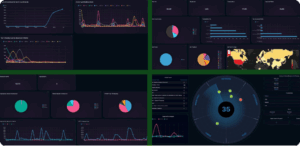
Every organization today depends on applications that are exposed to the Internet: online banking, patient portals, e-commerce sites, government systems, and more. These applications are your front door to the world—and unfortunately, they’re also the first target for attackers.
Most security strategies stop at protection. Firewalls, filters, and access controls are deployed to keep bad actors out. But here’s the problem: protecting alone doesn’t equal secure. Attacks evolve daily, configurations drift, and vulnerabilities are discovered faster than IT teams can patch them. The result? Even with protection in place, risk keeps growing.
That’s why organizations are shifting from protection-only security to real-time risk mitigation—a smarter approach that not only blocks attacks but also continuously reduces your exposure.
From Protection to Risk Management
The difference is simple but powerful. Protection is about tools. Risk mitigation is about outcomes.
Instead of asking, “Do we have a firewall?”, leaders are asking, “What is our actual level of risk today, and is it getting better or worse?”
This mindset comes straight from NIST 800-39, the U.S. standard for risk management in cybersecurity. It calls for organizations to frame, assess, respond to, and monitor risk on an ongoing basis—not just at audit time.
The Five Pillars of Real-Time Risk Mitigation
A modern solution for Internet-facing applications needs more than a shield. It needs five interconnected capabilities that work together to reduce risk in real time:
- Protection
- The starting point is still essential: stop attacks before they reach your applications.
- This means defending against denial-of-service attacks, bots, and exploitation attempts that threaten availability and data.
- Contextual Analysis
- Applications don’t exist in isolation. Behind every web portal are servers, devices, and connections that attackers can target.
- Real-time contextual analysis gives you visibility into the assets behind your applications and how they’re exposed.
- Vulnerability Management
- Hackers don’t guess—they look for known weaknesses.
- Continuous scanning at both the network and application level ensures those weaknesses are found and managed before attackers can exploit them.
- Threat Intelligence
- Yesterday’s defenses don’t stop tomorrow’s threats.
- By feeding live intelligence into defenses, organizations adapt faster—blocking emerging attack patterns before they hit.
- Validation of Controls
- Here’s the step most organizations skip: testing if defenses actually work.
- With breach & attack simulation, you continuously validate your security controls—proving they do what they’re supposed to do.
Together, these pillars don’t just protect. They continuously measure and reduce risk, providing business leaders with real-time visibility and confidence.
Why This Matters to Business Leaders
For many executives, cybersecurity still feels like a black box—full of tools, jargon, and alerts, but unclear in business terms. Real-time risk mitigation changes that:
- Visibility: You see your exposure and progress in real time.
- Alignment: Security is tied directly to governance frameworks like NIST 800-39.
- Efficiency: Instead of chasing alerts, your teams focus on what reduces risk fastest.
- Resilience: Your applications stay available and trustworthy even under attack.
In short, you’re no longer managing tools—you’re managing risk outcomes.
The Future of Application Security
Hackers don’t stop probing just because your pen test was “clean” last quarter. They operate 24/7. That means your defenses must do more than sit at the gate.
Real-time risk mitigation is the new standard. It’s proactive, adaptive, and measurable. It ensures your Internet-facing applications—and the business processes behind them—remain secure, available, and compliant.
Final Thought
Protecting your applications is necessary, but not sufficient. The real challenge is reducing risk in real time. That’s what modern, managed solutions deliver: protection, analysis, vulnerability management, intelligence, and validation working together—aligned with proven standards like NIST 800-39.
If your organization is ready to move beyond basic protection to true risk management for Internet-facing applications, let’s talk.
![]() NEWS POSTS
NEWS POSTS![]()




